Abstract
COVID-19 has had a huge impact on many industries around the world. Internationally-funded enterprises have been greatly affected by COVID-19 prevention and control measures, such as border controls. However, few studies have examined the impact of COVID-19 on internationally-funded enterprises. To this end, this paper considered 12 of China’s industrial parks situated in Southeast Asia, while comparing the operation status before and after the outbreak of COVID-19 based on remote sensing of nighttime lights (NTL). The NTL is generally used as a proxy for economic activity. First, six parameters were proposed to quantify and monitor the operation status based on NTL data. Subsequently, these parameters were calculated for the parks and for 10 km buffer zones surrounding them to analyze the differences in operating conditions. The results showed that (1) despite the negative impact of COVID-19, 9 out of the 12 parks had a mean NTL greater than 1, indicating that these parks are in better operating condition in 2020 than 2019; (2) 7 out of the 10 km buffer zones around the parks showed a decline in mean NTL. Only three parks showed a decline in mean NTL. The impact of COVID-19 on surrounding areas was greater than the impact on parks.
1. Introduction
In 2020, the outbreak of the COVID-19 virus caused great loss to the global economy. In June 2020, the International Monetary Fund (IMF) estimated that the global economy would shrink by 4.9% due to the impact of COVID-19 [1]. The IMF also predicted that the cumulative loss of global gross domestic product (GDP) in 2020 and 2021 would exceed US $12 trillion [1]. In March 2020, the International Labor Organization (ILO) predicted that 25 million people would be unemployed due to COVID-19 [2]. Accurately understanding the impact of COVID-19 on various industries is of great significance for policymakers to formulate targeted policies. In this paper, a method was proposed and evaluated using nighttime light (NTL) data to assess the impact of COVID-19 on the operation of foreign-funded industrial parks. Our main contribution is to propose a set of innovative quantitative impact monitoring index systems derived from NTL data, which can evaluate the impact of COVID-19 on the economy.
A cross-sectional correlation between light and economic activity was noticed in 1972 by Croft T. A. [3]. When the first night light sensor (operational line scan sensors) on board the Defense Meteorological Satellite Program (DMSP) satellite was launched in 1994, night light data began to be widely used to monitor social and economic activities. As reviewed by Donaldson D. and Storeygard A. [4], these studies can be predominantly divided into two categories. The first category mainly studies the correlation between NTL data and socioeconomic activities, especially the correlation with GDP. For example, Doll et al. (2006) found that NTL data was correlated with the national-level GDP of 11 European Union countries, while in the United States, NTL and GDP were correlated at several sub-national levels [5]. Henderson et al. (2012) measured economic growth using NTL data [6]. Chen et al. (2012) compared GDP and luminosity at the country level in developing countries for the period 1992–2008 [7]. Galimberti (2020) forecast GDP growth across a global sample of countries using NTL data [8]. Hu et al. (2020) constructed a global NTL dataset with a long time series (1992–2017) and found that the NTL data in China and India were positively correlated with their respective GDPs, with an R2-value higher than 0.85 [9]. In the absence of other data, light data can be utilized as a source of research to analyze socio-economic activity. This type of research includes socio-economic activity mapping at different scales [10,11], analysis of the impact of unexpected events (disasters/wars/epidemics, etc.) on socio-economic activities [12], and analysis of the development of socio-economic activities [13].
After the outbreak of COVID-19, NTL data quickly became an important tool for monitoring its economic impact, due to its large-scale and near-real-time characteristics. Liu et al. found that the monthly average NTL in China was much lower after the outbreak of COVID-19 [14]. Ghosh et al. and Elvidge et al. separately investigated the dimming of lights in India and China during the COVID-19 pandemic [15,16]. Yin et al. assessed the recovery of urban activity in 17 administrative regions of China during the early-2020 COVID-19 pandemic period using NTL data [17]. These findings indicate that COVID-19 has seriously affected the daily lives of people in China, India, and other countries around the world. Home quarantine, closures of schools, factories, shops, and other COVID-19 prevention, as well as control measures, have greatly slowed socio-economic activities [18]. This could lead to a rapid drop in both GDP and NTL index values [19,20].
However, to date, analysis of the socioeconomic impact of COVID-19 based on NTL data has mainly focused on the economic impacts in various countries. The impact of COVID-19 will differ according to different targets, industries, and groups of people. After the COVID-19 outbreak, lower levels of air pollutants were found in Egypt [21] and the southeastern United Kingdom [22]. While COVID-19 has had little impact on grain production in regions such as Hubei, China [23], it has brought continuous pressure on the global food supply chain in the form of lockdowns, economic declines, food trade restrictions, and rising food price inflation. Therefore, it has led to health crises in the least developed and developing economies [24]. Moreover, unemployment and bankruptcy have been reported in industries such as tourism, aviation, restaurants, and the sharing economy [18,25].
Foreign enterprises are an important driving force for global economic development, especially in developing countries. They have been severely impacted by COVID-19. Travel restrictions and border closures are the most widely used measures of COVID-19 prevention and control. Foreign-funded enterprises rely on cross-border personnel circulation and material supply, making them susceptible to the impacts of COVID-19 prevention and control measures. However, the impact of COVID-19 on foreign enterprises has received little attention. This makes policymakers unable to formulate targeted policies.
To address this problem, we have considered China’s Industrial Parks present in Southeast Asia (CIPSA) as case studies. The objective of this study is (1) to propose a quantitative monitoring method to monitor the CIPSA operations using NTL data before and after the outbreak of COVID-19, and (2) to compare and analyze the impacts of COVID-19 on CIPSAs and local markets.
The main innovations of this paper include the fact that the impact of COVID-19 on overseas parks has not yet been studied. We propose a quantitative monitoring method for the operational status of CIPSA parks. This includes a quantitative parameter system based on NTL data. We monitored the operation of CIPSA parks before and after the COVID-19 using NTL data. It is conducive for relevant departments to make targeted decisions.
2. Methods
2.1. Method Input and Processing Steps
To compare the operation status before and after the outbreak of COVID-19, a quantitative monitoring method based on NTL data was proposed in this paper. The input of this algorithm includes location information of CIPSAs, NTL time series, and COVID-19 case data. The location information of CIPSAs was in the shp file and used to subset NTL time series to the CIPSAs area. The NTL time series were utilized to extract quantitative NTL index and to further evaluate the CIPSA operations. COVID-19 case data were used to provide information such as the start time and changes of the epidemic. The algorithm was conducted by following steps (Figure 1): (1) data preprocessing; (2) calculation of quantitative parameters; (3) qualitative and quantitative analysis based on quantitative parameters; and (4) comparative analysis between industrial parks and 10 km buffer areas.
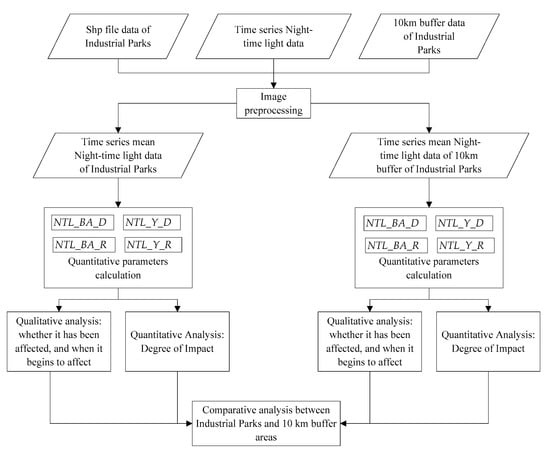
Figure 1.
Flowchart of the proposed algorithm.
2.2. Calculation of Quantitative Parameters
Generally, the temporal NTL curves for a particular region are similar in different years. Sudden changes in these curves are often caused by emergencies, such as the COVID-19 pandemic. To compare the operation status before and after the outbreak of COVID-19, the temporal mean NTL curves of each CIPSA and their 10 km buffer zones in 2020 and 2019 were drawn. Then, the differences between the 2019 and 2020 curves were evaluated by six ratio parameters to determine whether the operation of each park or 10 km buffer zone was deteriorating after the outbreak. Three parameters were utilized to compare with the pre-epidemic situation, whereas the other three parameters were used to compare with the same month in 2019.
2.2.1. Parameters Calculation for Comparing with the Pre-epidemic Situation
In most Southeast Asian countries, the first COVID-19 case was reported between January and March 2020. Thus, we ask the question: How much did the NTL index decrease after the outbreak started? To answer this question, three ratios of the NTL before and after the outbreak were used to measure the change. They were defined as:
where NTL_BA_D, NTL_BA_R, and NTL_BA_Ri are the ratio index of the NTL before and after the start of the outbreak; NTLmean,before is the mean NTL index from Jan to March 2020, NTLmin,after is the minimum NTL index of each park from April to December 2020, and NTLafter,i is the monthly mean NTL index of each park in month i from April to December 2020. The NTL_BA_D was used to evaluate the maximum decline in NTL after the epidemic, which was expressed as a percentage. The greater the value of NTL_BA_D, the greater the deterioration in the NTL index after the outbreak. The NTL_BA_Ri was used to evaluate the monthly decline of NT after the epidemic. It was more convenient for us to find out the month NTL started to decline and the month it went back to the pre-epidemic level. When NTL_BA_Ri < 1, the NTL index started to deteriorate in month i. The NTL_BA_R was used to evaluate the overall changes before and after the outbreak.
2.2.2. Parameters Calculation for Comparison with the Same Month in 2019
The second question is: compared to the same period of the previous year, how much did the NTL index decrease after the outbreak? To answer this question, we utilized another three ratio parameters, based on the NTL data ratio between 2019 and 2020, which can be defined as:
where NTL_Y_Di and NTL_Y_Ri are the ratio index of the NTL between 2019 and 2020 of month i, NTL2020,i and NTL2019,i are the NTL indexes in month i in 2020 and 2019, and NTLmean,2020 and NTLmean,2020 are the mean NTL indexes data of 2020 and 2019, respectively. The NTL_Y_Di represents the ratio of the decline in the NTL index caused by COVID-19 relative to the same period in the previous year. Greater values of NTL_Y_Di indicate a more serious impact of COVID-19. NTL_Y_R was used to evaluate the overall changes between 2019 and 2020. The NTL_Y_Ri was more convenient in working out the month NTL started to decline and the month it went back to the pre-epidemic level. If NTL_Y_Ri < 1, the mean NTL index is lower than in 2019. If the NTL_Y_Ri value of month i is equal to or greater than 1, it means that the mean NTL data for this month is equal to or greater than for the same month in 2019.
2.3. Qualitative Analysis of the Operation of Parks after the Outbreak of COVID-19
After the outbreak of COVID-19, two questions need to be answered first: (1) has the operation of the park deteriorated? (2) if it did, when did it start to deteriorate? Once the six ratio parameters are calculated, these questions could be answered.
Both cloud and COVID-19 could lead to changes in temporal NTL curves. However, clouds were removed in the data processing stage and were replaced by invalid values. Thus, when the data were not invalid, changes in the temporal NTL curves can be considered mainly due to COVID-19. These changes may lead to NTL values that are less than those before the COVID-19 outbreak or at the same month in 2019. For example, as the COVID-19 outbreak occurred in February 2020, the NTL values in March 2020 will be less than those in February 2020 and March 2019. The NTL_BA_R value can be used to evaluate whether the NTL decreased, followed by the COVID-19 outbreak. If NTL_BA_R < 1, we considered the operation of the park to have deteriorated before pre- COVID-19. When NTL_BA_Ri < 1, the deterioration started in month i compared to pre- COVID-19 year.
However, NTL data have obvious seasonal changes that could also cause smaller values than before the outbreak [26]. Thus, we compared the NTL data of each month in 2020 and 2019 to determine whether the operation of the park deteriorated. If the NTL of a park in 2020 was lower than that in 2019 (NTL_Y_R < 1), we considered the operation of the park to be deteriorated compared to the year 2019. When NTL_Y_Ri < 1, the deterioration was considered to start in month i in comparison to the year 2019.
2.4. Quantitative Analysis of the Impact of the COVID-19 Epidemic
After the six parameters were calculated, our questions can be answered quantitatively. The first question is, how much has the light index decreased after the outbreak of the COVID-19 epidemic compared to the pre-COVID-19? This question can be answered using the NTL_BA_D index, which shows the maximum decline in NTL post-COVID-19. The second question is, how much has the light index decreased under the influence of the COVID-19 compared with the NTL index in 2019? This question can be answered using the NTL_Y_D index, which was used to show the maximum decline in the worst situation.
With the advent of COVID-19, the operation of parks has been fluctuating. The recovery of the park’s operation is another concern. We have also investigated the recovery of the park’s operating conditions by comparing it with the pre-pandemic year, i.e., 2019. Two parameters (NTL_BA_Ri and NTL_Y_Ri) were utilized to investigate the restoration extent in the operation of the parks. The operation of the park was considered to be in pre-epidemic situation, once the NTL_BA_Ri > 1. At the same time, the operation of the park was considered to return to the same level as 2019 for NTL_Y_Ri > 1. Parameters such as NTL_BA_Ri and NTL_Y_Ri were calculated starting from April, as the period from January to March 2020 was considered as pre-epidemic. Table 1 represents the parameters and their usage as adopted in this paper.

Table 1.
Parameters and their usage.
2.5. NTL Comparison of Foreign Parks and 10 km Buffer Zones
After the outbreak of COVID-19, various countries issued a series of measures to control its spread. The most commonly adopted measures include: (1) border control, such as the suspension of international flights and tourist visas, closure of borders, and prevention of entry by foreign citizens, and (2) controlling the gathering of people, such as the closure of factories, restaurants, and cinemas. Foreign companies tend to have more foreign employees and rely on the international product supply chain. Therefore, border control measures could result in staff shortages and supply chain disruptions for foreign enterprises. The foreign companies are expected to be severely affected by COVID-19, with a slower recovery chance.
To evaluate the difference in the impact of COVID-19 on foreign companies and the local economy, the NTL time series of CIPSA and the local economy were compared. First, a 10 km buffer zone was applied to each park. These buffer zones were assumed to represent the local economy while inheriting similar economic development conditions to the park. Since these areas were very close to the parks, the COVID-19 prevention and control measures implemented in these areas should be similar to those at the park. Subsequently, the monthly average NTL time series from January 2019 to December 2020 in each buffer zone was calculated. Then, the six ratio parameters for each buffer zone were calculated. Finally, differences in these six parameters between the parks and buffer zones were compared to analyze the (1) change in NTL before and after the outbreak of COVID-19 and (2) the economic recovery in the post-COVID recovery phase. For higher NTL_BA_D and NTL_Y_Di values, the impact of COVID-19 was considered to be serious. The recovery was found to be slower once the time of NTL_BA_Ri and NTL_Y_Ri reached 1.0 later.
3. Method Test and Results
3.1. Study Area and Data
3.1.1. Study Area
Industrial parks are an important platform for Chinese foreign investment, with more than 30% of Chinese enterprises being concentrated in industrial parks in various countries [27,28]. China’s overseas industrial parks dataset collected by Li et al. included 182 industrial parks [29]. Southeast Asia contains the largest number of Chinese industrial parks and has a close economic relationship with China. However, only 47 industrial parks in this dataset have accurate location information. Among them, 14 parks are located in Southeast Asia and two of these parks are very small. Thus, only twelve CIPSAs situated in Thailand, Vietnam, Cambodia, Laos, and Malaysia were selected as our research objective. Detailed information on these parks is provided in Figure 2 and Table 2.
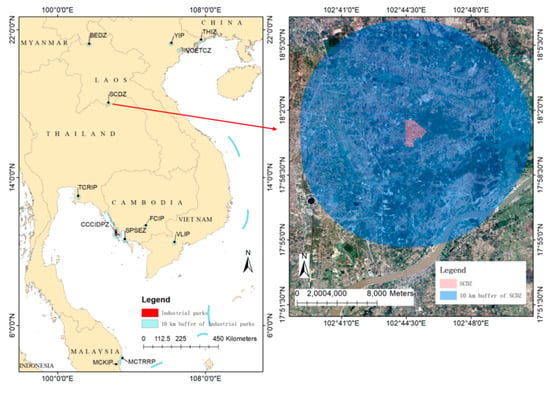
Figure 2.
Location map of China’s Industrial Parks in Southeast Asia.

Table 2.
Industrial parks studied in this paper.
3.1.2. Data and Data Preprocessing
Dataset
The latest generation NTL consists of Day-Night Band (DNB) data acquired by the Visible and Infrared Imaging Suite (VIIRS) incorporated with the Joint Polar-orbiting Satellite System (JPSS). The data was acquired on an everyday basis at a spatial resolution of 500 m. Monthly and annual cloud-free DNB composites were also provided by the Earth Observation Group (EOG) [30]. Cloud and stray light were removed from the monthly and annual DNB products provided by the EOG (https://eogdata.mines.edu/products/vnl/, accessed on 5 February 2022).
Monthly cloud-free DNB composites of these twelve CIPSAs from January 2018 to December 2020 were used here because Southeast Asia is a cloudy and rainy region. Due to the influence of clouds, it was considerably difficult to find cloud-free luminous data covering the entire Southeast Asia. If daily data or weekly data were used, there will be a lot of invalid data. Monthly composite data can combine the cloud-free day data on different dates into monthly data to greatly reduce the impact of clouds. As presented in Table 2, the number of completely cloud-free data exceeds 20 for most of the parks. Monthly or annual DNB data is high-level data that removes cloud and stray light while making the storage format easier to handle. This provides the user an easier data preprocessing step, especially in time series analysis. Therefore, these two kinds of data are widely utilized [9,10,11,12,13,14,15,16,31].
The COVID-19 dataset was downloaded from the World Health Organization webpage (https://COVID19.who.int/, accessed on 5 February 2022). It contains four parameters (new cases, cumulative cases, new deaths, cumulative deaths) to measure the impacts of COVID-19 in each country.
Data Preprocessing
The 36-month VIIRS DNB dataset covering Southeast Asia from January 2018 to December 2020 were processed as follows, while being presented in Figure 3 as well:
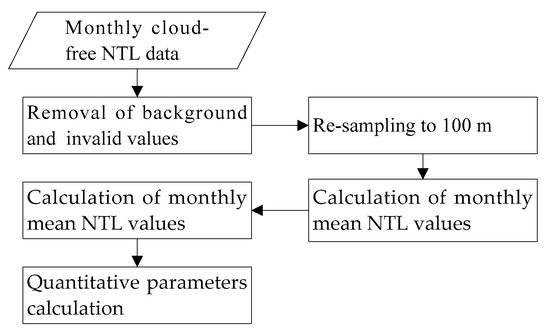
Figure 3.
Flowchart of the preprocessing of NTL data.
- (1)
- Since cloud and stray light was removed in monthly products by the EOG, additional cloud and stray light removal processes were not needed.
- (2)
- Removal of background and invalid values. Pixels with poor-quality data due to cloud cover or solar illumination were set to zero. In addition, there was very little background noise in the NTL data. These zero invalid values and ground noise should be removed when the mean or sum NTL values are calculated. Ghosh et al. (2020) removed such ground noise by masking NTL values < 0.6 nanowatt/cm2/sr while calculating the summed NTL values for India [15]. Here, ten regions of interest without human activity in Southeast Asia were selected to calculate the background noise value. The mean NTL value of these ten regions was 0.5 nanowatt/cm2/sr. Therefore, NTL values < 0.5 nanowatt/cm2/sr in each month NTL dataset were set to -NaN values to remove background and invalid values. NTL data of Parks with background and invalid values of more than 50% were also removed to ensure the high quality of the data used.
- (3)
- Due to the small size of certain parks, the number of pixels covering these parks turned out to be low. This could result in outliers when statistical means are calculated. To increase the number of pixels, we resampled the NTL imagery to 100 m using the nearest neighboring pixel method in ENVI 4.3 software (ITT Industries, Inc., Boulder, CO, USA).
- (4)
- The monthly mean NTL values of each CIPSA park and in 10 km buffer zones around each CIPSA in 2018, 2019, and 2020 were calculated using the statistical tools in ENVI 5.3 software. Figure 4 shows the monthly mean and standard deviation (Stdev) nighttime light values of Yunzhong Industrial Park, Beijiang Province, Vietnam, from January 2019 to December 2020.
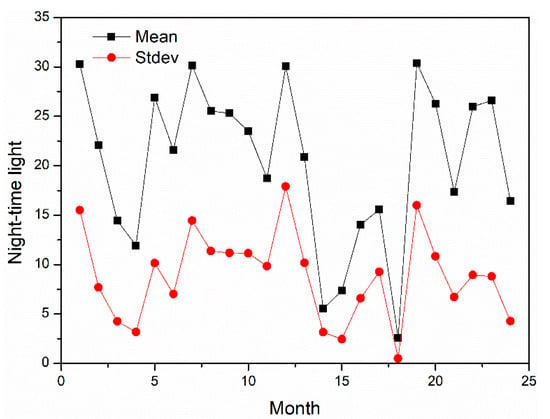 Figure 4. The monthly mean and standard deviation (Stdev) nighttime light values of Yunzhong Industrial Park, Beijiang Province, Vietnam, from January 2019 to December 2020.
Figure 4. The monthly mean and standard deviation (Stdev) nighttime light values of Yunzhong Industrial Park, Beijiang Province, Vietnam, from January 2019 to December 2020. - (5)
- The monthly mean NTL values were used to calculate the NTL index, and the operation status before and after the outbreak were compared.
3.2. Results
3.2.1. Results of China’s Southeast Asian Industrial Parks Operation Monitoring
Results of Qualitative Analysis of Parks
Table 3 shows the qualitative monitoring results of parks. Compared to the pre- COVID-19 year, only two parks displayed NTL_BA_R value less than 1. Therefore, the operation status of those two parks was severely impacted by the COVID-19 outbreak. Only three parks demonstrated to have NTL_Y_R value less than 1. This indicated that the operation status of those three parks in 2020 was worse than in 2019. However, there were 11 parks with NTL_Y_Ri values < 1, indicating the fluctuation in their operation status. The NTL data of most of the parks started to decline in January. The timing of the emergence of COVID-19 cases in Southeast Asian countries was from January to March 2020. This shows that the operation of these parks and surrounding areas was rapidly affected after the outbreak of COVID-19. The SCDZ was the only park with a NTL_Y_Ri value > 1 for all of the months, as it is still under construction. The construction area increased from 0.36 km2 on 12 April 2019 to 0.82 km2 on 23 November 2020, which increased its NTL value (Figure 5).

Table 3.
Influence of COVID-19 on parks and surrounding 10 km buffer zones.
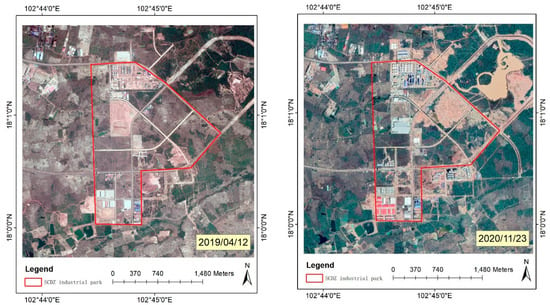
Figure 5.
0.5 m remote sensing image of SCDZ acquired on 12 April 2019 and 23 November 2020.
Figure 6 shows the temporal NTL curves of the parks and buffer zones in 2019 and 2020. As can be seen from the Figure 6, except for the SCDZ park, the 2019 NTL curve and the 2020 NTL curve of other parks intersect. This means that the operation of these parks in 2020 was fluctuating. This is the same result as the analysis with parameter NTL_Y_Ri.
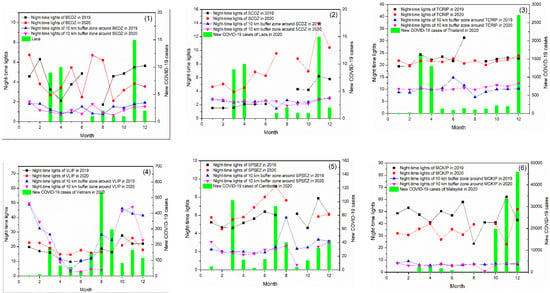

Figure 6.
(1)–(12)Time series curves of NTL at each CIPSA park and 10 km buffer zone (lines) and new COVID-19 cases (columns) in 2019 and 2020.
(1)–(12)Time series curves of NTL at each CIPSA park and 10 km buffer zone (lines) and new COVID-19 cases (columns) in 2019 and 2020.
Results of Quantitative Parameter Analysis of Parks
The result of the maximum decline in NTL of the 12 parks after the start of COVID-19 epidemic is presented in Table 4. It can be seen that the NTL_BA_D values of 11 parks were greater than 0, with a mean NTL_BA_D of 24.42%. This indicated that the NTL values of these parks were lower before the beginning of COVID-19. The NTL_BA_D values of the two parks were greater than 50%, indicating the significant impact of COVID-19 on their operation. The maximum NTL_Y_D values of 11 parks were greater than 0, with a mean maximum NTL_Y_D of 32.05%. The maximum NTL_Y_D values of the three parks increased by more than 50%. Due to the influence of COVID-19, the operations of these three parks were far worse in 2020 than in 2019.

Table 4.
Analysis of COVID-19 impacts on the operations of CIPSAs, according to the four ratio parameters.
All of the parks had NTL_BA_Ri values greater than 1, which indicated their operational restoration to a pre-COVID-19 level for some months. Most of the parks exhibited an NTL_BA_R value greater than 1 in April or May.
3.2.2. Comparison of the Impacts of COVID-19 on Foreign Enterprises and Local Areas
Results of Qualitative Analysis of 10 km Buffer of Parks
In Table 3, compared with pre- COVID-19, seven buffer zones had NTL_BA_R values less than 1. This means the operational status of those seven buffer zones was bad after the outbreak of COVID-19. The number of buffer zones which had NTL_Y_R values less than 1 was also 7. This indicated that the operation status of those seven buffer zones in 2020 was worse than in 2019.
Table 5 represents the NTL_BA_D values of 10 km buffer zones, which are greater than 0, with a mean of 43.21%. The NTL_BA_D values of five of the buffer zones were greater than 50%. The maximum NTL_Y_Di values of all buffer zones were greater than 0, with a mean NTL_BA_D of 49.84%. The maximum NTL_Y_Di values of six of the buffer zones were greater than 50%. Due to the influence of COVID-19, the operation of these six buffer zones were far worse in 2020 than in 2019.

Table 5.
Analysis of COVID-19 impacts on 10 km buffer zones around parks, according to the four ratio parameters.
Comparison between the Parks and of 10 km Buffer
As shown in Table 3, seven 10 km buffer zones around the parks displayed a decline in NTL (NTL_Y_R < 1), while only three parks demonstrated a decline. All parks and 10 km buffer zones displayed at least one NTL_BA_Ri or NTL_Y_Ri values greater than 1. The month with NTL_BA_Ri or NTL_Y_Ri value greater than 1 were also compared (Table 4). The first month with NTL_BA_Ri or NTL_Y_Ri values greater than 1 is highlighted in bold. For example, for BEDZ park, the first NTL_BA_Ri > 1 in May, while it is July for the 10 km buffer zones. Thus, we highlighted May in Table 4. There are nine parks with the first time of NTL_BA_Ri > 1 earlier than the 10 km buffer zones, while it is one 10 km buffer zone with the time earlier than the park. There are five parks with the first time of NTL_Y_Ri > 1 earlier than the 10 km buffer zones, while there are four 10 km buffer zones with the time earlier than the parks. Thus, the parks recovered better than the buffer zones. The parks recovered 1–5 months earlier than their respective buffer areas. For example, the NTL_BA_Ri and NTL_Y_Ri values for BEDZ were above 1 for May and April, while the values for the 10 km buffer zone did not increase above 1 until July and May, which are two and one months later, respectively. Therefore, the recovery of 10 km buffer zones lagged behind that of the parks. From the above analysis, we can understand that the buffer zones had worse values than the parks in all indicators. Thus, COVID-19 had a greater impact on the public than on industrial parks. This may be due to the difference in COVID-19 prevention and control measures adopted by different industries. The impacts of travel and crowd aggregation restrictions on restaurants, hotels, cinemas, and other service industries were far greater than those on factories.
4. Discussion
4.1. Comparison of 2018, 2019, and 2020
The special event of 2020 was the outbreak of COVID-19. Parameter NTL_Y_R2020 is the change between 2020 and 2019. We further calculated the changes between 2019 and 2018-parameter NTL_Y_R2019. Then, parameters NTL_Y_R2020 and NTL_Y_R2019 were compared to find out the impact of COVID-19. The results are presented in Figure 7a. It was found that there are nine parks and seven buffer zones with NTL_Y_R2019 > 1, while the numbers are nine and five with NTL_Y_R2020 > 1, respectively. This indicated that the NTL of these parks and buffer zones increased in 2019 compared to 2018. The buffer zones showed bad performance in 2020. There are eight parks with NTL_Y_R2019 > NTL_Y_R2020, while only six buffer zones with NTL_Y_R2019 > NTL_Y_R2020. This indicated that the NTL of these parks and buffer zones increased more significantly in 2019.
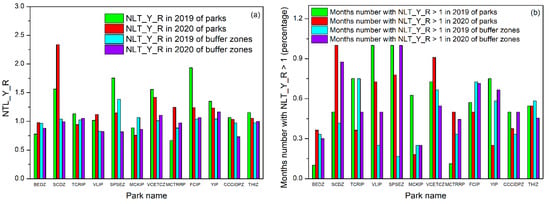
Figure 7.
Change comparison of parks and buffer zones between 2018, 2019, and 2020 (a,b).
Monthly NTL_Y_R2019,i was also calculated to show the monthly change between 2019 and 2018. The number of months (NM2019) with NTL_Y_R2019,i > 1 was counted, which indicated that the NTL of 2019 in month i was higher than 2018 while having NM2020 with NTL_Y_R2020,i > 1. Due to the influence of the cloud, there was no data for certain months. Moreover, the NM2019 and NM2020 cannot be directly compared. Thus, the NM2019 and NM2020 were divided by the number of months with data from 2019 and 2020 to obtain NM2019,p and NM2020,p in percentage. Figure 7b shows the results of a comparison between NM2019,p and NM2020,p. It was found that there were seven parks with NM2019,p > NM2020,p, while there were only three buffer zones with NM2019,p > NM2020,p. Based on the above parameters, it can be understood that although the NTL of most parks increased in 2020, the rise was less significant in 2019. This can be seen clearly from the NTL curve of SPSEZ park from January 2018 to December 2020 (Figure 8).
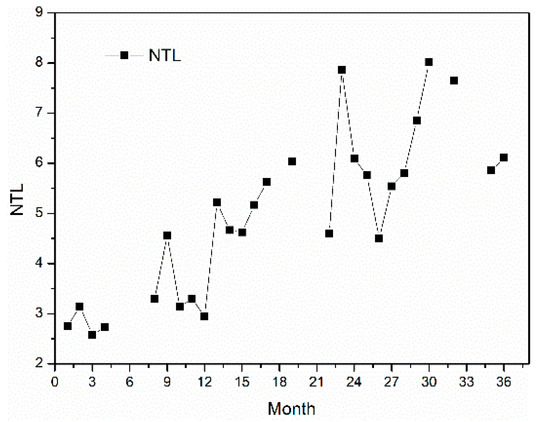
Figure 8.
The monthly mean nighttime light values of Sihanouk Port Special Economic Zone, Cambodia, from January 2018 to December 2020.
4.2. Impacts of COVID-19 Prevention and Control Measures on New COVID-19 Cases and the Economy
Figure 6 shows the impact of prevention and control measures on the number of new COVID-19 cases and the economy. After the outbreak of COVID-19, strict COVID-19 prevention and control measures were implemented, such as border closures, travel restrictions, and the closure of shops and factories. This study revealed a rapid decline in both new COVID-19 cases and the NTL index in this period, which is consistent with the results of Shen et al. [32]. Both new COVID-19 cases and monthly NTL values declined due to COVID-19 prevention and control measures. As these measures were gradually lifted, the economy recovered quickly. However, if the removal of prevention and control measures before COVID-19 cases are eliminated, then that could lead to a rapid increase in cases. This is called premature unblocking. Premature unblocking can lead to early restoration of the economy but can also lead to the rapid occurrence of another wave of cases, with the peak being higher than that of the preceding wave.
4.3. Influence of Land-Use Types
Table 6 presents the comparison of the impact of COVID-19 on CIPSAs and their surrounding 10 km buffer zones. These CIPSAs were located in two land-cover types (rural and urban). Comparisons of the mean NTL_BA_D and mean maximum NTL_Y_D values revealed that the impact of COVID-19 was greater in rural parks than in urban. Rural parks showed better recovery than city parks as they all had NTL_Y_R values greater than 1, while one of the urban parks did not.

Table 6.
Comparison of the impacts of COVID-19 on rural and urban parks and buffer zones.
However, when examining the 10 km buffer zones, the impacts of COVID-19 were found to be very similar in rural and urban areas. The city zones exhibited worst recovery than the rural zones. All the buffer zones of rural parks had NTL_Y_Ri values greater than 1, while two of the buffer zones of urban parks did not. For urban buffer zones, the land-use type was the city, usually residential. For rural buffer zones, the land-use types were rural, usually farmland. Thus, rural areas would be less affected by COVID-19 and could recover better.
4.4. Limitations
- (1)
- Southeast Asia is cloudy and rainy. Due to the influence of clouds, there are a large number of default values in the daily and monthly NTL data in this area. This limits the sensitivity of using NTL data to monitor the operation of the park, making it difficult to catch short-term changes in operation. In less cloudy areas, daily NTL data can be considered to increase the sensitivity of monitoring.
- (2)
- The spatial resolution of NTL data acquired by VIIRS is 500 m. Some industrial parks are very small. This makes them difficult to monitor using VIIRS NTL data. On 5 November 2021, China launched the Sustainable Development Science Satellite 1 (SDGSAT-1). It was equipped with a night light sensor with a 10 m resolution. The use of high-resolution night light data was more suitable for the monitoring of park targets.
- (3)
- The COVID-19 data used in this study were national-scale data and the night lighting data were gridded data. The difference in data scales means that we can only discuss the relationships between the number of COVID-19 cases, the NTL index and COVID-19 prevention, as well as control measures. Detailed analysis of the relationships between these three factors requires data with consistent scales. For example, national-scale NTL and COVID-19 data can be used together to analyze the impact of COVID-19 on national economics.
- (4)
- NTL data can be utilized to monitor the overall operation of the park. However, the operation of the park is affected by many factors, such as raw material supply, energy supply, personnel mobility, and market fluctuations. More data is required to analyze the specific impact of COVID-19.
5. Conclusions
This study used NTL time series data for Southeast Asia from 2018 to 2020 to analyze the impact of COVID-19 on China’s Southeast Asian Parks. The operation of parks and local areas was also compared using six parameters. The results show that:
- (1)
- Despite the negative impact of COVID-19, 9 of the 12 parks had a NTL_Y_R2020 index greater than 1, indicating that these parks were in better operating condition in 2020 than in 2019. However, there were nine parks whose NTL_Y_R2020 index was lower than the NTL_Y_R2019 index. This indicates that due to the impact of COVID-19, the growth rate of the park had declined.
- (2)
- The 2019 NTL curve and the 2020 NTL curve of 11 parks intersect. This indicates that the operation of these parks in 2020 was fluctuating, from being sometimes worse than that in 2019 and sometimes better. The maximum NTL_Y_D values of 11 of the parks which were used to evaluate the maximum monthly decline was greater than 0, with a mean maximum NTL_Y_D of 32.05%. The maximum NTL_Y_D values of three of the parks increased by more than 50%.
- (3)
- Compared to pre- COVID-19, there are 10 parks with a NTL_BA_R index greater than 1, indicating that these parks were in better operating condition post-COVID-19 than pre-COVID-19. However, NTL_BA_D values of 11 of the parks were greater than 0, with a mean NTL_BA_D of 24.42%, which means that the NTL values of these parks in a month were lower than pre-COVID-19.
- (4)
- The impact of COVID-19 on surrounding areas was greater than the impact on the parks. Seven 10 km buffer zones around the parks showed a decline in NTL (NTL_Y_R < 1), while only three parks demonstrated a decline after the outbreak of COVID-19. Further, compared to the same period in the previous year, the parks also recovered better than the buffer zones, with the parks recovering 1–5 months earlier than their respective buffer zones.
- (5)
- The impact of COVID-19 on city areas was greater than that in rural areas in terms of both the mean NTL_BA_D and mean maximum NTL_Y_D values, in both parks and their 10 km buffer zones. Further, rural parks showed better recovery than urban parks.
Author Contributions
Conceived and designed the experiments, Mingquan Wu, Huichun Ye, Zheng Niu, Wenjiang Huang, Pengyu Hao, Wang Li and Bo Yu; performed the experiments and the manuscript draft, Mingquan Wu; directed the experiments, Huichun Ye, Zheng Niu and Wenjiang Huang; revised the manuscript draft, Huichun Ye, Zheng Niu, Wenjiang Huang, Pengyu Hao, Wang Li and Bo Yu. All authors have read and agreed to the published version of the manuscript.
Funding
This work was supported by the Strategic Priority Research Program of the Chinese Academy of Sciences (XDA19030304) and the Youth Innovation Promotion Association CAS (Grant 2017089 and 2018084).
Institutional Review Board Statement
Not applicable.
Informed Consent Statement
Not applicable.
Data Availability Statement
Not applicable.
Conflicts of Interest
The authors declare no conflict of interest.
References
- XIN Wang ANET. Spotlight: IMF Revises down Global Economy Forecast amid Mounting COVID-19 Fallout, Warning of Rec-ord Debt Levels. Available online: http://www.xinhuanet.com/english/2020-06/25/c_139164949.htm (accessed on 20 April 2021).
- Chinadaily. COVID-19 a “Labor Market Crisis”. Available online: https://www.chinadailyhk.com/article/126024 (accessed on 20 April 2021).
- Croft, T.A. Burning Waste Gas in Oil Fields. Nature 1973, 245, 375–376. [Google Scholar] [CrossRef]
- Donaldson, D.; Storeygard, A. The View from Above: Applications of Satellite Data in Economics. J. Econ. Perspect. 2016, 30, 171–198. [Google Scholar] [CrossRef] [Green Version]
- Doll, C.N.; Muller, J.-P.; Morley, J.G. Mapping regional economic activity from night-time light satellite imagery. Ecol. Econ. 2006, 57, 75–92. [Google Scholar] [CrossRef]
- Henderson, J.V.; Storeygard, A.; Weil, D.N. Measuring Economic Growth from Outer Space. Am. Econ. Rev. 2012, 102, 994–1028. [Google Scholar] [CrossRef] [Green Version]
- Chen, X.; Nordhaus, W.D. Using luminosity data as a proxy for economic statistics. Proc. Natl. Acad. Sci. USA 2011, 108, 8589–8594. [Google Scholar] [CrossRef] [Green Version]
- Galimberti, J.K. Forecasting GDP Growth from Outer Space. Oxf. Bull. Econ. Stat. 2020, 82, 697–722. [Google Scholar] [CrossRef] [Green Version]
- Hu, Y.; Zhang, Y. Global Nighttime Light Change from 1992 to 2017: Brighter and More Uniform. Sustainability 2020, 12, 4905. [Google Scholar] [CrossRef]
- Henderson, J.V.; Squires, T.; Storeygard, A.; Weil, D. The Global Distribution of Economic Activity: Nature, History, and the Role of Trade1. Q. J. Econ. 2018, 133, 357–406. [Google Scholar] [CrossRef]
- Wang, X.; Sutton, P.C.; Qi, B. Global Mapping of GDP at 1 km2 Using VIIRS Nighttime Satellite Imagery. ISPRS Int. J. Geo-Information 2019, 8, 580. [Google Scholar] [CrossRef] [Green Version]
- Li, X.; Zhan, C.; Tao, J.; Li, L. Long-Term Monitoring of the Impacts of Disaster on Human Activity Using DMSP/OLS Nighttime Light Data: A Case Study of the 2008 Wenchuan, China Earthquake. Remote Sens. 2018, 10, 588. [Google Scholar] [CrossRef] [Green Version]
- Wang, R.; Wan, B.; Guo, Q.; Hu, M.; Zhou, S. Mapping Regional Urban Extent Using NPP-VIIRS DNB and MODIS NDVI Data. Remote Sens. 2017, 9, 862. [Google Scholar] [CrossRef] [Green Version]
- Liu, Q.; Sha, D.; Liu, W.; Houser, P.; Zhang, L.; Hou, R.; Lan, H.; Flynn, C.; Lu, M.; Hu, T.; et al. Spatiotemporal Patterns of COVID-19 Impact on Human Activities and Environment in Mainland China Using Nighttime Light and Air Quality Data. Remote Sens. 2020, 12, 1576. [Google Scholar] [CrossRef]
- Ghosh, T.; Elvidge, C.; Hsu, F.-C.; Zhizhin, M.; Bazilian, M. The Dimming of Lights in India during the COVID-19 Pandemic. Remote Sens. 2020, 12, 3289. [Google Scholar] [CrossRef]
- Elvidge, C.; Ghosh, T.; Hsu, F.-C.; Zhizhin, M.; Bazilian, M. The Dimming of Lights in China during the COVID-19 Pandemic. Remote Sens. 2020, 12, 2851. [Google Scholar] [CrossRef]
- Yin, R.; He, G.; Jiang, W.; Peng, Y.; Gong, C. Night-Time Light Imagery Reveals China’s City Activity during the COVID-19 Pandemic Period in Early 2020. IEEE J. Sel. Top. Appl. Earth Obs. Remote Sens. 2021, 14, 5111–5122. [Google Scholar] [CrossRef]
- Nguyen, H.T.T.; Nguyen, T.T.; Dam, V.A.T.; Nguyen, L.H.; Vu, G.T.; Nguyen, H.T.; Le, H.T. COVID-19 Employment Crisis in Vietnam: Global Issue, National Solutions. Front. Public Health 2020, 8, 590074. [Google Scholar] [CrossRef]
- Goldsztejn, U.; Schwartzman, D.; Nehorai, A. Public policy and economic dynamics of COVID-19 spread: A mathematical modeling study. PLoS ONE 2020, 15, e0244174. [Google Scholar] [CrossRef]
- Pan, W.; Huang, G.; Shi, Y.; Hu, C.; Dai, W.; Pan, W.; Rongsheng, H. COVID-19: Short-Term Influence on China’s Economy Considering Different Scenarios. Glob. Chall. 2021, 5, 2000090. [Google Scholar] [CrossRef]
- Mostafa, M.K.; Gamal, G.; Wafiq, A. The impact of COVID 19 on air pollution levels and other environmental indicators—A case study of Egypt. J. Environ. Manag. 2021, 277, 111496. [Google Scholar] [CrossRef]
- Wyche, K.P.; Nichols, M.; Parfitt, H.; Beckett, P.; Monks, P.S. Changes in ambient air quality and atmospheric composi-tion and reactivity in the south east of the UK as a result of the COVID-19 lockdown. Sci. Total Environ. 2021, 755, 142526. [Google Scholar] [CrossRef]
- Wang, Y.; Peng, D.; Yu, L.; Zhang, Y.; Yin, J.; Zhou, L.; Zheng, S.; Wang, F.; Li, C. Monitoring Crop Growth During the Period of the Rapid Spread of COVID-19 in China by Remote Sensing. IEEE J. Sel. Top. Appl. Earth Obs. Remote Sens. 2020, 13, 6195–6205. [Google Scholar] [CrossRef]
- Erokhin, V.; Gao, T. Impacts of COVID-19 on Trade and Economic Aspects of Food Security: Evidence from 45 Developing Countries. Int. J. Environ. Res. Public Health 2020, 17, 5775. [Google Scholar] [CrossRef]
- Hossain, M. The effect of the COVID-19 on sharing economy activities. J. Clean. Prod. 2021, 280, 124782. [Google Scholar] [CrossRef]
- Levin, N. The impact of seasonal changes on observed nighttime brightness from 2014 to 2015 monthly VIIRS DNB composites. Remote Sens. Environ. 2017, 193, 150–164. [Google Scholar] [CrossRef]
- Song, T.; Liu, W.; Liu, Z.; Wuzhati, Y. Chinese overseas industrial parks in Southeast Asia: An examination of policy mobility from the perspective of embeddedness. J. Geogr. Sci. 2018, 28, 1288–1306. [Google Scholar] [CrossRef] [Green Version]
- Liu, Z.; Dunford, M.; Liu, W. Coupling national geo-political economic strategies and the Belt and Road Initiative: The China-Belarus Great Stone Industrial Park. Politi-Geogr. 2021, 84, 102296. [Google Scholar] [CrossRef]
- Li, H.M.; Wu, M.Q.; Niu, Z.; Li, Q. Information dataset of China’s overseas industrial parks from 1992 to 2018. China Sci. Data 2019, 4. [Google Scholar]
- Elvidge, C.D.; Baugh, K.; Zhizhin, M.; Hsu, F.C.; Ghosh, T. VIIRS night-time lights. Int. J. Remote Sens. 2017, 38, 5860–5879. [Google Scholar] [CrossRef]
- Zhu, Y.; Xu, D.; Ali, S.H.; Ma, R.; Cheng, J. Can Nighttime Light Data Be Used to Estimate Electric Power Consumption? New Evidence from Causal-Effect Inference. Energies 2019, 12, 3154. [Google Scholar] [CrossRef] [Green Version]
- Shen, X.; Cai, C.; Li, H. Socioeconomic restrictions slowdown COVID-19 far more effectively than favorable weather-evidence from the satellite. Sci. Total Environ. 2020, 748, 141401. [Google Scholar] [CrossRef] [PubMed]
Publisher’s Note: MDPI stays neutral with regard to jurisdictional claims in published maps and institutional affiliations. |
© 2022 by the authors. Licensee MDPI, Basel, Switzerland. This article is an open access article distributed under the terms and conditions of the Creative Commons Attribution (CC BY) license (https://creativecommons.org/licenses/by/4.0/).